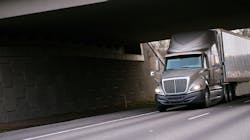Congress overturns Clean Truck Plan, but Biden readies veto pen
Congress overturned the Biden administration's more stringent heavy-truck emissions rules, but the Republican-led move is expected to be met by the president's veto.
After the Senate voted to overturn the Environmental Protection Agency regulations in April, the House followed suit on May 23. The Congressional Review Act legislation was aimed at the EPA rule that affects commercial vehicles beginning in 2027.
Since the Clean Truck Plan regulations were introduced, Republican legislators have criticized the rule as overly burdensome to smaller fleets and owner-operators. Deb Fischer (R-Nebraska), who initiated the review act, said the stricter rules would encourage companies to keep older equipment longer. She added that the higher costs associated with emissions control would be passed on to consumers and could disrupt supply chains.
Democrats have championed the stricter rules as part of sweeping emissions reforms to combat climate change and reduce the nation's reliance on fossil fuels.
“Truckers care about clean air as much as anyone else, but are also on the front lines of the supply chain with over 70% of America’s freight relying exclusively on trucking," said Todd Spencer, president of the Owner-Operator Independent Drivers Association. "Mandating equipment that has historically led to major engine reliability issues under an unrealistic timeline will have devastating effects on the reliability of America’s supply chain and ultimately on the cost and availability of consumer goods.”
The review act allows a simple majority in both chambers of Congress to overturn executive branch action, such as federal rulemaking. The Senate voted 50-49 to overturn the regulations, with Senator Joe Manchin of West Virginia the only Democrat to vote for repeal. The House voted 221-203 to rescind the EPA regulation.
The White House has said that President Biden would veto the bill. Based on the nearly party-line votes, Congress wouldn't have enough votes to override the veto.
EPA's Clean Truck Plan
The EPA's new emissions rules were finalized in January and took effect in March. This gives OEMs less than four years to apply the regulations to heavy-duty trucks and engines by model year 2027.
The aim is to reduce air pollution, including pollutants that create ozone and particulate matter, by increasing emission reductions over time as newer and cleaner vehicles enter the market. EPA estimates the rule would reduce heavy-duty vehicle NOx emissions by 40% by 2040. The rule is designed to have most large trucks running on low- or zero-emission powertrains by 2045, cutting NOx by nearly 50% compared to today's emissions.
To meet the standards for heavy-duty commercial vehicles, NOx emissions must not exceed 0.035 grams per horsepower hour during regular use, 0.050 grams on low load, and 10 grams while idling. The new regulations also include extended warranties, from 100,000 miles to 450,000 miles, and longer functional life for covered commercial vehicles, from 435,000 miles to 650,000 miles.
The new rules are the first part of EPA's three-step Clean Truck Plans, followed by the proposed Phase 3 GHG standards for heavy-duty vehicles starting with model year 2027 trucks. The other part of the plan includes multipollutant standards for light- and medium-duty vehicles.
"The line of demarcation that most people refer to with diesel technology emissions was 2010," Andrew Boyle, co-president of Boyle Transportation and first vice chairman of the American Trucking Associations, told a Senate subcommittee on April 18. "Right now, if we look at the national fleet of Class 8 trucks, 47% of them are still pre-2010."
Excise tax overshadows lower-emission fleet costs
Boyle told the Senate's Environmental and Public Works climate subcommittee that Congress could help by removing obstacles to buying more efficient diesel trucks. According to ATA, modern diesel equipment produces 99% less emissions than the same class of vehicles built in 1988.
He said that smaller fleets and independent drivers tend to run older equipment because of the upfront costs for new trucks.
"A huge impediment to buying newer, cleaner trucks—even today's trucks—is the Federal Excise Tax that was installed more than 100 years ago to finance World War I," Boyle said. "So a big issue, when we look at the emissions in aggregate right now, is not so much that today's trucks aren't clean enough. It's just that of the fleet on the road—not enough are today's trucks. This is one level we have to make it more affordable for fleets and operators to buy today's trucks."
Since its implementation in 1917, the Federal Excise Tax (FET) has quadrupled from a 3% levy on truck purchases to a 12% surcharge on heavy-duty tractors, trucks, and trailers. According to Boyle, the price differential between battery-electric Class 8 trucks and their diesel counterparts is around $300,000, which government incentives barely cover when added to the FET.
Past attempts to repeal the tax with bipartisan support have been unsuccessful. However, the American Trucking Associations, American Truck Dealers, and Zero Emission Transportation Association have recently urged Congress to repeal the FET in the interest of promoting decarbonization and safety.
This story originally appeared on FleetOwner.com.
About the Author

Josh Fisher
Technology Editor
FleetOwner Editor-in-Chief Josh Fisher has been with Endeavor's Commercial Vehicle Group since 2017, covering everything from modern fleet management to operational efficiency, artificial intelligence, autonomous trucking, regulations, and emerging transportation technology. He is based in Maryland.
